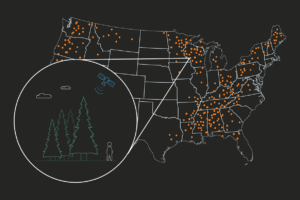NCX Guides
Tree Planting Programs
Landowners today have access to a wide variety of both old and new tree planting programs.
How should you evaluate different programs to find the right one for you and your land?
In this guide, we’ll explore the different types of tree planting programs and how to decide which one is right for you and your land.
What Trees are Being Planted?
Choosing a tree species to plant is an important decision. The trees you put in the ground today will alter your land for decades to come.
-
01 Native species
Environmentally-focused programs tend to favor native species that will improve ecosystem health
-
02 Loblolly pine
Timber and carbon programs tend to favor fast-growing commercial species like loblolly pine.
-
03 Genetically-modified seedlings
There are even some new approaches that use genetically-modified or specially treated seedlings that aim to increase growth rates even further.
HOW IT WORKS
When are Trees Being Planted?
The typical planting windows in the US are in the spring and in the fall. Keep an eye on the enrollment deadlines for the projects you’re considering. If you miss out, you may have to wait a year before your next chance to participate.

Why Do They Want to Plant Trees on Your Land?
A good place to start is understanding the program partner and their motivations.
-
Environmental benefits
Land improvement
Planting trees can create wildlife habitat and improve soil health and water quality. Typically, programs focused on environmental benefits are run by the government or nonprofit conservation groups.
-
Carbon credits
Removing carbon dioxide
As trees grow, they pull carbon dioxide out of the air and store carbon as wood. This carbon storage can be measured and certified as a “carbon credit.” Corporations can buy these credits to demonstrate their commitment to climate action. A variety of for-profit and not-for-profit organizations run these carbon-focused tree planting programs.
-
Timber harvest
Monetizing trees
Our houses, furniture, paper, packaging, and much more are made from trees. The timber and wood fiber markets are well established and harvesting trees is one of the traditional ways of monetizing forested land. These timber-oriented programs tend to be run by traditional forest industry organizations or investment firms.

Where are Trees Being Planted?
Using digital mapping technology, NCX can help you understand which parts of your property are eligible for which programs.
How are Trees Being Planted?
Planting trees is a lot of work! A typical tree planting project requires site preparation, seedling purchase and transport, putting the trees in the ground, and doing a final inspection. These costs can run into hundreds of dollars per acre and the logistics and contracting are non-trivial. Some programs handle the whole process and pay the full cost, some do a cost-share, and others require the landowner to pay and manage the whole process.
For each program, NCX breaks down the schedule of out-of-pocket costs so you can understand the impact this has on your bottom line. NCX strongly recommends that you work with a forester to oversee any tree planting project. If you don’t already work with a forester, NCX can help you find one in your area
Risks, Rewards, and Restrictions
Not every tree that you plant will survive. Of the trees that do survive, not all will grow equally well. That’s just the reality of working in nature. Make sure that you know who bears the risk for failed planting and lower-than-expected growth. In many programs, it’s the landowner… that’s you. If your planting is successful, who reaps the rewards? Typically, the revenue streams from tree planting come in the following forms.
-
“Rental” payments
Fixed annual payments are most common in government programs like CRP. You’ll receive these annual payments over the full term of the contract as long as your trees survive.
-
Carbon credits
For programs that generate carbon credits, landowners can sometimes choose to receive payment in carbon credits, a revenue-share from the sale of carbon credits, or fixed cash payments. Each of these options has risks which we’ll cover in a future article.
-
Timber harvest
Selling timber is a major driver of value for landowners. Before you enroll in any program, make sure you know who has the rights to harvest your timber. Note that many carbon programs often place significant restrictions on your ability to conduct a timber harvest.
Don’t forget about price fluctuations either. The price for carbon or timber can go up or down. Even if you lock in a price now, remember that inflation can erode your earnings significantly, especially for long-term contracts.
Finally, make sure you understand any restrictions you’re agreeing to. Are you allowed to harvest any of the timber? Do you have to grant access to your land? Can you still hunt? Do you have to put any easements on the property? How long do these restrictions last?
